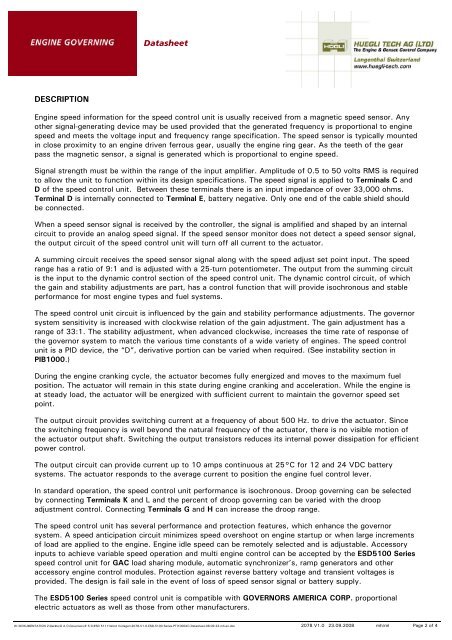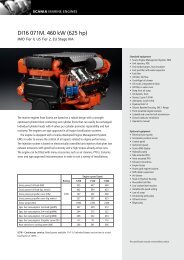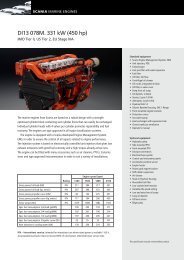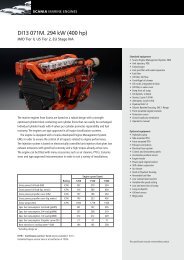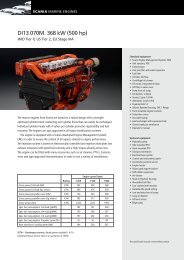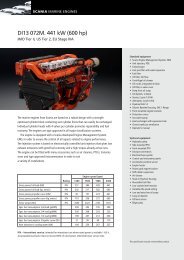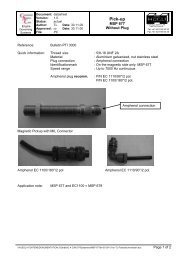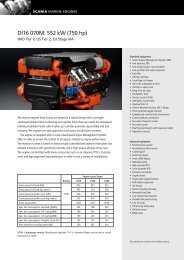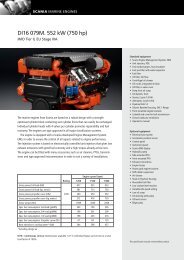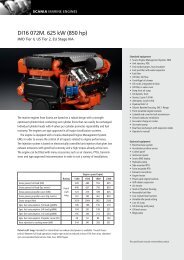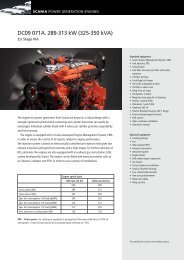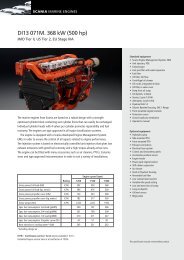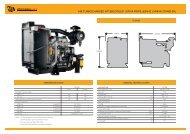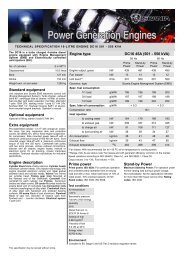ESD-5100 Series - Speed control Unit - Huegli Tech
ESD-5100 Series - Speed control Unit - Huegli Tech
ESD-5100 Series - Speed control Unit - Huegli Tech
Create successful ePaper yourself
Turn your PDF publications into a flip-book with our unique Google optimized e-Paper software.
DESCRIPTION<br />
Datasheet<br />
Engine speed information for the speed <strong>control</strong> unit is usually received from a magnetic speed sensor. Any<br />
other signal-generating device may be used provided that the generated frequency is proportional to engine<br />
speed and meets the voltage input and frequency range specification. The speed sensor is typically mounted<br />
in close proximity to an engine driven ferrous gear, usually the engine ring gear. As the teeth of the gear<br />
pass the magnetic sensor, a signal is generated which is proportional to engine speed.<br />
Signal strength must be within the range of the input amplifier. Amplitude of 0.5 to 50 volts RMS is required<br />
to allow the unit to function within its design specifications. The speed signal is applied to Terminals C and<br />
D of the speed <strong>control</strong> unit. Between these terminals there is an input impedance of over 33,000 ohms.<br />
Terminal D is internally connected to Terminal E, battery negative. Only one end of the cable shield should<br />
be connected.<br />
When a speed sensor signal is received by the <strong>control</strong>ler, the signal is amplified and shaped by an internal<br />
circuit to provide an analog speed signal. If the speed sensor monitor does not detect a speed sensor signal,<br />
the output circuit of the speed <strong>control</strong> unit will turn off all current to the actuator.<br />
A summing circuit receives the speed sensor signal along with the speed adjust set point input. The speed<br />
range has a ratio of 9:1 and is adjusted with a 25-turn potentiometer. The output from the summing circuit<br />
is the input to the dynamic <strong>control</strong> section of the speed <strong>control</strong> unit. The dynamic <strong>control</strong> circuit, of which<br />
the gain and stability adjustments are part, has a <strong>control</strong> function that will provide isochronous and stable<br />
performance for most engine types and fuel systems.<br />
The speed <strong>control</strong> unit circuit is influenced by the gain and stability performance adjustments. The governor<br />
system sensitivity is increased with clockwise relation of the gain adjustment. The gain adjustment has a<br />
range of 33:1. The stability adjustment, when advanced clockwise, increases the time rate of response of<br />
the governor system to match the various time constants of a wide variety of engines. The speed <strong>control</strong><br />
unit is a PID device, the “D”, derivative portion can be varied when required. (See instability section in<br />
PIB1000.)<br />
During the engine cranking cycle, the actuator becomes fully energized and moves to the maximum fuel<br />
position. The actuator will remain in this state during engine cranking and acceleration. While the engine is<br />
at steady load, the actuator will be energized with sufficient current to maintain the governor speed set<br />
point.<br />
The output circuit provides switching current at a frequency of about 500 Hz. to drive the actuator. Since<br />
the switching frequency is well beyond the natural frequency of the actuator, there is no visible motion of<br />
the actuator output shaft. Switching the output transistors reduces its internal power dissipation for efficient<br />
power <strong>control</strong>.<br />
The output circuit can provide current up to 10 amps continuous at 25°C for 12 and 24 VDC battery<br />
systems. The actuator responds to the average current to position the engine fuel <strong>control</strong> lever.<br />
In standard operation, the speed <strong>control</strong> unit performance is isochronous. Droop governing can be selected<br />
by connecting Terminals K and L and the percent of droop governing can be varied with the droop<br />
adjustment <strong>control</strong>. Connecting Terminals G and H can increase the droop range.<br />
The speed <strong>control</strong> unit has several performance and protection features, which enhance the governor<br />
system. A speed anticipation circuit minimizes speed overshoot on engine startup or when large increments<br />
of load are applied to the engine. Engine idle speed can be remotely selected and is adjustable. Accessory<br />
inputs to achieve variable speed operation and multi engine <strong>control</strong> can be accepted by the <strong>ESD</strong><strong>5100</strong> <strong>Series</strong><br />
speed <strong>control</strong> unit for GAC load sharing module, automatic synchronizer’s, ramp generators and other<br />
accessory engine <strong>control</strong> modules. Protection against reverse battery voltage and transient voltages is<br />
provided. The design is fail sale in the event of loss of speed sensor signal or battery supply.<br />
The <strong>ESD</strong><strong>5100</strong> <strong>Series</strong> speed <strong>control</strong> unit is compatible with GOVERNORS AMERICA CORP. proportional<br />
electric actuators as well as those from other manufacturers.<br />
W:\DOKUMENTATION 2\Geräte\G A C\Governors\E S D\<strong>ESD</strong> 5111\Word Vorlagen\2078-V1.0-<strong>ESD</strong>-<strong>5100</strong> <strong>Series</strong>-PTI1000XC-Datasheet-08-09-23-mh-en.doc 2078 V1.0 23.09.2008 mh/ml Page 2 of 4


